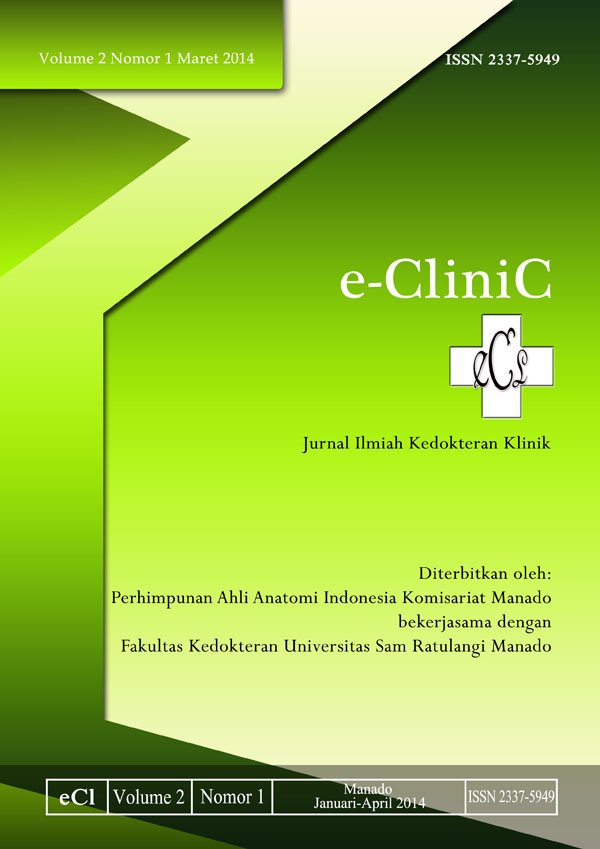HUBUNGAN HELICOBACTER PYLORI DENGAN BERATNYA KEJADIAN INFARK MIOKARD AKUT PADA PASIEN RAWAT INAP DI ICCU RS SEKITAR MANADO PERIODE NOVEMBER 2013 SAMPAI JANUARI 2014
DOI:
https://doi.org/10.35790/ecl.v2i1.3749Abstract
Abstract: Acute myocardial infarction (AMI) is one of the most frequent causes of death in the United States and other developed countries and estimated the possible relationship between infectious agents in atherosclerosis. Several studies have reported H.pylori infection associated with cardiovascular disease and H.pylori relationship with inflammatory responses in acute myocardial infarction, but only a few researchers who seek a relationship the severity of H.pylori with AMI, although the results are not meaningful. Objective: To determine the correlation between Helicobacter pylori with the severity of acute myocardial infarction case. Methods: This study used a prospective cohort study with observational-analytic approach. The samples in this study were patients AMI in hospitals around Manado period November 2013 - January 2014 with purposive sampling techniques for sampling, the severity of AMI is assessed from measurements Left Ventricle Ejection Fraction (LVEF) using 2D echocardiography and analyzed using Chi-Square test statistic. Results: With the patients who experienced AMI (n = 22), we found six samples (27%) were infected H.pyori and all have FEVK> 30%, and 16 samples (73%) were not infected with H. pylori with two samples have FEVK <30% and 14 samples have FEVK> 30%. The results of the Chi-square test showed that there was no significant correlation between the H.pylori with the severity of the Acute myocardial infarction case (p = 1.000). Conclusions: There was no significant correlation between the H.pylori with the severity of the Acute myocardial infarction case.
Keywords: H.pylori, acute myocardial infarction
Â
Abstrak: Infark Miokard Akut (IMA) merupakan salah satu penyebab kematian paling sering di Amerika Serikat dan negara-negara maju lainnya dan diperkirakan adanya kemungkinan hubungan antara agen infeksius dengan aterosklerosis. Beberapa penelitian melaporkan infeksi H.pylori berkaitkan dengan penyakit kardiovaskular dan adanya hubungan H.pylori dengan respon inflamasi pada infark miokard akut, tetapi hanya beberapa peneliti yang mencari hubungan H.pylori dengan beratnya IMA walaupun hasilnya tidak bermakna. Tujuan: Untuk mengetahui hubungan antara H.pylori dengan beratnya kejadian Infark Miokard Akut. Metode: Penelitian ini menggunakan studi kohort prospektif dengan pendekatan observasional-analitik. Sampel dalam penelitian ini adalah pasien IMA di RS sekitar Manado periode November 2013 – Januari 2014 dengan teknik purposive sampling untuk pengambilan sampel, beratnya IMA dinilai dari pengukuran FEVK menggunakan ekokardiografi 2D dan dianalisa dengan menggunakan uji statistik Chi-Square. Hasil: Dari pasien yang mengalami IMA (n=22) ditemukan enam sampel (27%) terinfeksi H.pyori dan semuanya memiliki FEVK >30%, serta 16 sampel (73%) tidak terinfeksi H.pylori dengan dua sampel memiliki FEVK <30% dan 14 sampel memiliki FEVK >30%. Hasil uji Chi-square menunjukkan bahwa tidak terdapat hubungan yang bermakna antara H.pylori dengan beratnya kejadian Infark Miokard Akut (p=1.000). Kesimpulan: Tidak terdapat hubungan yang bermakna antara H.pylori dengan beratnya kejadian Infark Miokard Akut.
Kata kunci: H.pylori, infark miokard akut
Downloads
How to Cite
Issue
Section
License
COPYRIGHT
Authors who publish with this journal agree to the following terms:
Authors hold their copyright and grant this journal the privilege of first publication, with the work simultaneously licensed under a Creative Commons Attribution License that permits others to impart the work with an acknowledgment of the work's origin and initial publication by this journal.
Authors can enter into separate or additional contractual arrangements for the non-exclusive distribution of the journal's published version of the work (for example, post it to an institutional repository or publish it in a book), with an acknowledgment of its underlying publication in this journal.
Authors are permitted and encouraged to post their work online (for example, in institutional repositories or on their website) as it can lead to productive exchanges, as well as earlier and greater citation of the published work (See The Effect of Open Access).







